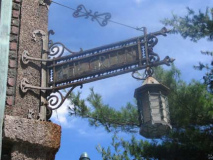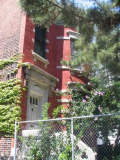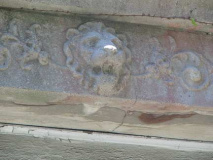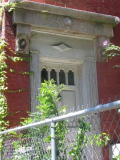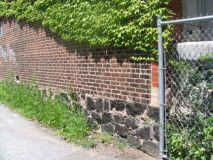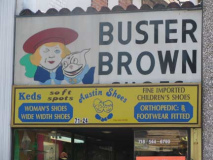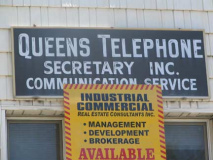 Cord Meyer Jr. (1854-1910) was the original developer of Elmhurst and Forest Hills. In 1893 Meyer, a successful banker and lawyer, purchased acreage in what was then called Newtown from British retail magnate Samuel Lord of Lord & Taylor fame and proceeded to lay out a street pattern that still exists today, built utilities and sewers, and introduced retail businesses and a bank.
Cord Meyer Jr. (1854-1910) was the original developer of Elmhurst and Forest Hills. In 1893 Meyer, a successful banker and lawyer, purchased acreage in what was then called Newtown from British retail magnate Samuel Lord of Lord & Taylor fame and proceeded to lay out a street pattern that still exists today, built utilities and sewers, and introduced retail businesses and a bank.
In 1906 Meyer’s development company turned its attention to Whitepot, just to Elmhurst’s southeast.
LEFT: new Forest Hills office building
“Whitepot” came form a Dutch term, whiteput, meaning “hollow creek” (in those days Horse Brook still meandered through the area). The colonial-era Whitepot Road is today’s Yellowstone Boulevard. Meyer’s company purchased 600 acres from the Springsteen, Squire, Lott, Bolmer, van Siclen and Ascan Bakus farms (Bakus’ given name became a Forest Hills avenue) and renamed it Forest Hills; Meyer had a history of “upscaling” areas by giving them a more harmonious name, converting the prosaic Newtown to Elmhurst.
In 1908-1909 Meyer sold several acres south of the Long Island Rail Road to the Russell Sage Homes Foundation:
A pair of scenes from Forest Hills Gardens. The bridge at right is actually a part of a private residence.
Margaret Olivia Sloan Sage, the head of the foundation envisioned a model community of beautiful tree-lined streets and small parks, with housing for all: the wealthy, “the middle class” trades people and blue collar workers. The development of Forest Hills Gardens becomes so expensive that the original idea to include homes for the “lower class” was scraped. Mortgages were offered, but the minimum monthly payments of $25 could only be afforded by upper or middle income families. The architects chosen were Grosvenor Atterbury and his partner John Almy Tompkins and landscaping was left up to Olmstead Brothers Landscape Architects (nephews of Frederick Law Olmstead the designer of Central Park.) Rigid restrictions and building specifications were set to preserve the character of Forest Hills Gardens. Building were to be in stone, brick or cement in Tudor or Georgian styles, the roofs red tiles or slate. Queensnewyork
The Last of Meyer
Attractive as they are, Forest Hills Gardens don’t really concern us today on FNY — a smattering of small attached brick buildings on 72nd Avenue between Austin Street and Queens Boulevard do. They were built shortly after Meyer’s purchase of the farms on one of the first streets to be developed, Roman Avenue, later 72nd.
According to the Central Queens Historical Association these rowhouses were built in 1906 for the area’s first plumber, electrician and carpenter. A plaque hung last year on the front of the property at 108-19 72nd Ave. commemorates the two houses’ 100th anniversary. It reads: “Built in 1906, they were the beginnings of this historic, beautiful community.” The central two properties, shown above, have been placed on the market for $4 million, with air rights advertised that would allow future developers to raze them and erect offices similar to the building shown at the top of the page. This is not an unfounded fear as in recent years, similar rowhouses across the avenue have been bulldozed.
The NYC Landmarks Preservation Commission rejected landmark status for these buildings, as it seems to do in many Queens instances, claiming they did not evidence “a special historical or aesthetic interest or value as part of the development, heritage, or cultural characteristics of the city.” As you can see the rowhouses’ fellows on either side have been shamefully compromised (as anyone with even a pedestrian sense of taste can see, with ponderous additions and fake stonework, as well as an unfortunate whitewashing).
It’s FNY’s position, though, that history should play an equal role in landmarking decisions; these are the last remaining buildings constructed by the area’s developer.
The rowhouse closest to Austin Street looks much like it did in its heyday. It’s unwhitewashed and retains much of its old stonework, including its stone foundation.
Commission Rejects Request To Landmark Forest Hills Site [Queens Chronicle]
Enndangered rowhouses need your help (includes a photo of the houses in their heyday) [Queens Crap]
Media action on 72nd townhouses [Queens Central]
If you support the preservation of this corner of Queens history, write Michael Perlman, Chairman of the “Rego-Forest Preservation Council,” which advocates for the preservation of potential individual landmarks & potential historic districts, throughout Forest Hills & Rego Park at unlockthevault@hotmail.com or contact the Central Queens Historic Association at PO Box N, Kew Gardens, NY 11415, 1-718-793-2255.
We’ll finish with a pair of hand-lettered and painted signs in the immediate vicinity. Tige looked vaguely vicious years ago.


